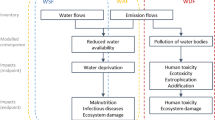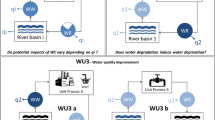Abstract
Purpose
A complete assessment of water use in life cycle assessment (LCA) involves modelling both consumptive and degradative water use. Due to the range of environmental mechanisms involved, the results are typically reported as a profile of impact category indicator results. However, there is also demand for a single score stand-alone water footprint, analogous to the carbon footprint. To facilitate single score reporting, the critical dilution volume approach has been used to express a degradative emission in terms of a theoretical water volume, sometimes referred to as grey water. This approach has not received widespread acceptance and a new approach is proposed which takes advantage of the complex fate and effects models normally employed in LCA.
Methods
Results for both consumptive and degradative water use are expressed in the reference unit H2Oe, enabling summation and reporting as a single stand-alone value. Consumptive water use is assessed taking into consideration the local water stress relative to the global average water stress (0.602). Concerning degradative water use, each emission is modelled separately using the ReCiPe impact assessment methodology, with results subsequently normalised, weighted and converted to the reference unit (H2Oe) by comparison to the global average value for consumptive water use (1.86 × 10−3 ReCiPe points m−3).
Results and discussion
The new method, illustrated in a simplified case study, incorporates best practice in terms of life cycle impact assessment modelling for eutrophication, human and eco-toxicity, and is able to assimilate new developments relating to these and any other impact assessment models relevant to water pollution.
Conclusions
The new method enables a more comprehensive and robust assessment of degradative water use in a single score stand-alone water footprint than has been possible in the past.
Similar content being viewed by others
References
Bayart JB, Bulle C, Deschênes L, Margni M, Pfister S, Vince F, Koehler A (2010) A framework for assessing off-stream freshwater use in LCA. Int J Life Cycle Assess 15:439–453
Berger M, Finkbeiner M (2010) Water footprinting: how to assess water use in life cycle assessment? Sustainability 2:919–944
Chapagain AK, Hoekstra AY, Savenije HHG, Gautam R (2006) The water footprint of cotton consumption: an assessment of the impact of worldwide consumption of cotton products on the water resources in the cotton producing countries. Ecol Econ 60:186–203
EU-JRC [European Commission-Joint Research Centre — Institute for Environment and Sustainability] (2011) International Reference Life Cycle Data System (ILCD) Handbook—Recommendations for life cycle impact assessment in the European context, 1st edn. Publications Office of the European Union, Luxemburg
Finnveden G, Hauschild MZ, Ekvall T, Guinee J, Heijungs R, Hellweg S, Koehler A, Pennington D, Suh S (2009) Recent developments in life cycle assessment. J Environ Manage 91:1–21
Goedkoop M, Spriensma R (2000) The Eco-indicator 99: A damage oriented method for life cycle assessment: Methodology report, 2nd edn. Pré Consultants BV, Amersfoort, The Netherlands
Goedkoop M, Heijungs R, Huijbregts M, De Schryver A, Struijs J, van Zelm R (2009) ReCiPe 2008: A life cycle impact assessment method which comprises harmonised category indicators at the midpoint and the endpoint level, 1st edn. Ruimte en Milieu, Ministerie van Volkshuisvesting, Ruimtelijke Ordening en Milieubeheer, The Netherlands
Koehler A (2008) Water use in LCA: managing the planet’s freshwater resources. Int J Life Cycle Assess 13:451–455
Kounina A, Margni M, Bayart JB, Boulay AM, Berger M, Bulle C, Frischknecht R, Koehler A, Mila-i-Canals L, Motoshita M, Núñez M, Peters G, Pfister S, Ridoutt BG, van Zelm R, Verones F, Humbert S (2011) Review of methods addressing freshwater availability in life cycle inventory and impact assessment. Int J Life Cycle Assess (in revision)
Masters B, Rohde K, Gurner N, Higham W, Drewry J (2008) Sediment, nutrient and herbicide runoff from canefarming practices in the Mackay Whitsunday region: a field-based rainfall simulation study of management practices. Queensland Department of Natural Resources and Water for the Mackay Whitsunday Natural Resource Management Group, Australia
Page G, Ridoutt BG, Bellotti W (2011) Fresh tomato production for the Sydney market: an evaluation of options to reduce the environmental impacts of agricultural water use. Agric Water Manag 100:18–24
Pfister S, Hellweg S (2009) The water "shoesize" vs. footprint of bioenergy. Proc Natl Acad Sci U S A 106:E93–E94
Pfister S, Koehler A, Hellweg S (2009) Assessing the environmental impacts of freshwater consumption in LCA. Environ Sci Technol 43:4098–4104
Pfister S, Saner D, Koehler A (2011) The environmental relevance of water consumption in global power production. Int J Life Cycle Assess 16:580–591
Pfister S, Vionnet S, Humbert S (2012) Ecoinvent 3: assessing water use in LCA and facilitating water footprinting. Int J Life Cycle Assess (in review)
Ridoutt BG, Pfister S (2010a) A revised approach to water footprinting to make transparent the impacts of consumption and production on global freshwater scarcity. Glob Environ Chang 20:113–120
Ridoutt BG, Pfister S (2010b) Reducing humanity’s water footprint. Environ Sci Technol 44:6019–6021
Ridoutt BG, Poulton PL (2010) Dryland and irrigated cropping systems: comparing the impacts of consumptive water use. In: Notarnicola et al. (eds) Proc VII international conference on life cycle assessment in the agri-food sector. Università degli Studi di Bari Aldo Moro, pp 153–158
Ridoutt BG, Juliano P, Sanguansri P, Sellahewa J (2010a) The water footprint of food waste: case study of fresh mango in Australia. J Clean Prod 18:1714–1721
Ridoutt BG, Williams R, Baud S, Fraval S, Marks N (2010b) The water footprint of dairy products: case study involving skim milk powder. J Dairy Sci 93:5114–5117
Ridoutt BG, Sanguansri P, Freer M, Harper GS (2012a) Water footprint of livestock: comparison of six geographically defined beef production systems. Int J Life Cycle Assess 17:165–175
Ridoutt BG, Sanguansri P, Nolan M, Marks N (2012b) Meat production and water scarcity: Beware of generalizations. J Clean Prod 28:127–133
Rockström J, Steffen W, Noone K, Persson Å, Chapin FS, Lambin EF, Lenton TM, Scheffer M, Folke C, Schellnhuber HJ, Nykvist B, de Wit CA, Hughes T, van der Leeuw S, Rodhe H, Sörlin S, Snyder PK, Costanza R, Svedin U, Falkenmark M, Karlberg L, Corell RW, Fabry VJ, Hansen J, Walker B, Liverman D, Richardson K, Cruzen P, Foley JA (2009) A safe operating space for humanity. Nature 461:472–475
Verones F, Hanafiah MM, Pfister S, Huijbregts MAJ, Pelletier GJ, Koehler A (2010) Characterisation factors for thermal pollution in freshwater aquatic environments. Environ Sci Technol 44:9364–9369
Weidema BP, Thrane M, Christensen P, Schmidt J, Løkke S (2008) Carbon footprint: a catalyst for life cycle assessment? J Ind Ecol 12:3–6
Acknowledgements
This study was jointly funded by CSIRO, Australia and ETH Zurich.
Author information
Authors and Affiliations
Corresponding author
Additional information
Responsible editor: Jane Bare
Electronic supplementary material
Below is the link to the electronic supplementary material.
ESM 1
(DOC 64 kb)
Rights and permissions
About this article
Cite this article
Ridoutt, B.G., Pfister, S. A new water footprint calculation method integrating consumptive and degradative water use into a single stand-alone weighted indicator. Int J Life Cycle Assess 18, 204–207 (2013). https://doi.org/10.1007/s11367-012-0458-z
Received:
Accepted:
Published:
Issue Date:
DOI: https://doi.org/10.1007/s11367-012-0458-z




